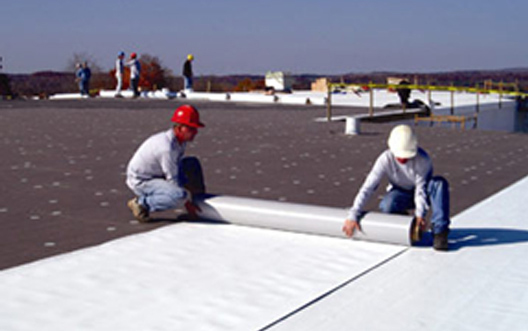Polyvinyl Chloride (PVC) membrane roofing is also known as vinyl roofing. Vinyl is derived from two simple ingredients: fossil fuel (Petroleum or natural gas) and salt
Thermoplastic PVC roofing is extremely strong, as its heat-welded seams form a permanent, watertight bond that is stronger than the membrane itself. PVC resin is modified with plasticizers and UV stabilizers, and reinforced with fiberglass non-woven mats or polyester woven scrims, for use as a flexible roofing membrane. PVC is, however, subject to plasticizer migration. (a process by which the plasticizers migrate out of the sheet causing it to become brittle.) Thus a thicker membrane has a larger reservoir of plasticizer to maintain flexibility over its lifespan.
Vinyl roofs are inherently fire resistant due to their chemical composition and have a broader range of fire ratings over common substrates.
PVC has been sold for commercial roofing use for more than 60 years. Vinyl roofing membranes' long life cycle – and the associated lower energy consumption to both produce the raw material and process it into useful products – is a significant factor in their sustainability as a building product
Vinyl roofs provide an energy-efficient roofing option due to their inherently light coloring. While the surface of a black roof can experience a temperature increase of as much as 90 degrees under the heat of the full sun, a white reflective roof typically increases only 10-25 degrees Fahrenheit
Vinyl membranes can also be used in waterproofing applications for roofing. This is a common technique used in association with green, or planted, roofs
It worthy of note that many Green Building organizations recommend not using PVC roofing due to significant environmental hazards from the toxicity of the manufacturing process as well as the noxious compounds released in a fire such as hydrochloric acid fumes and byproducts including dioxin, a potent carcinogen
